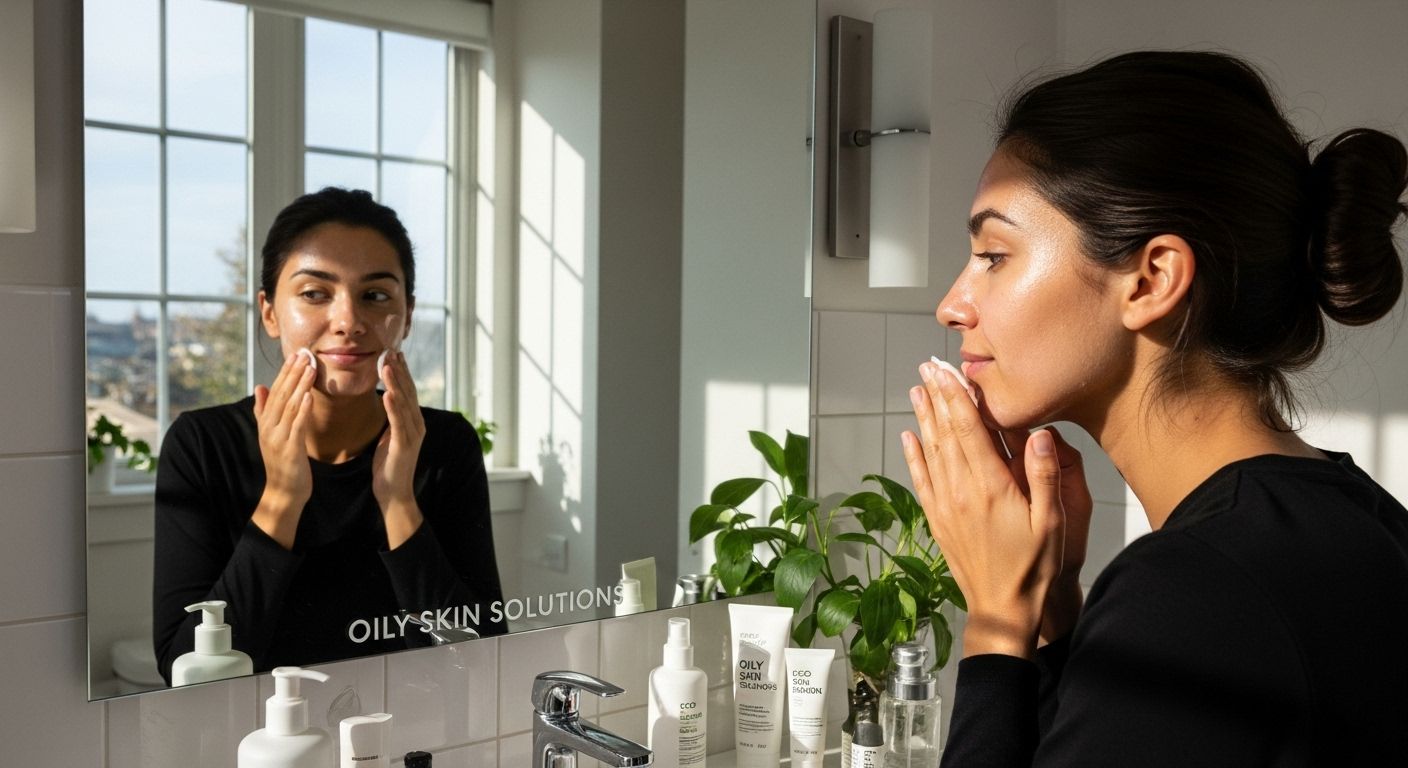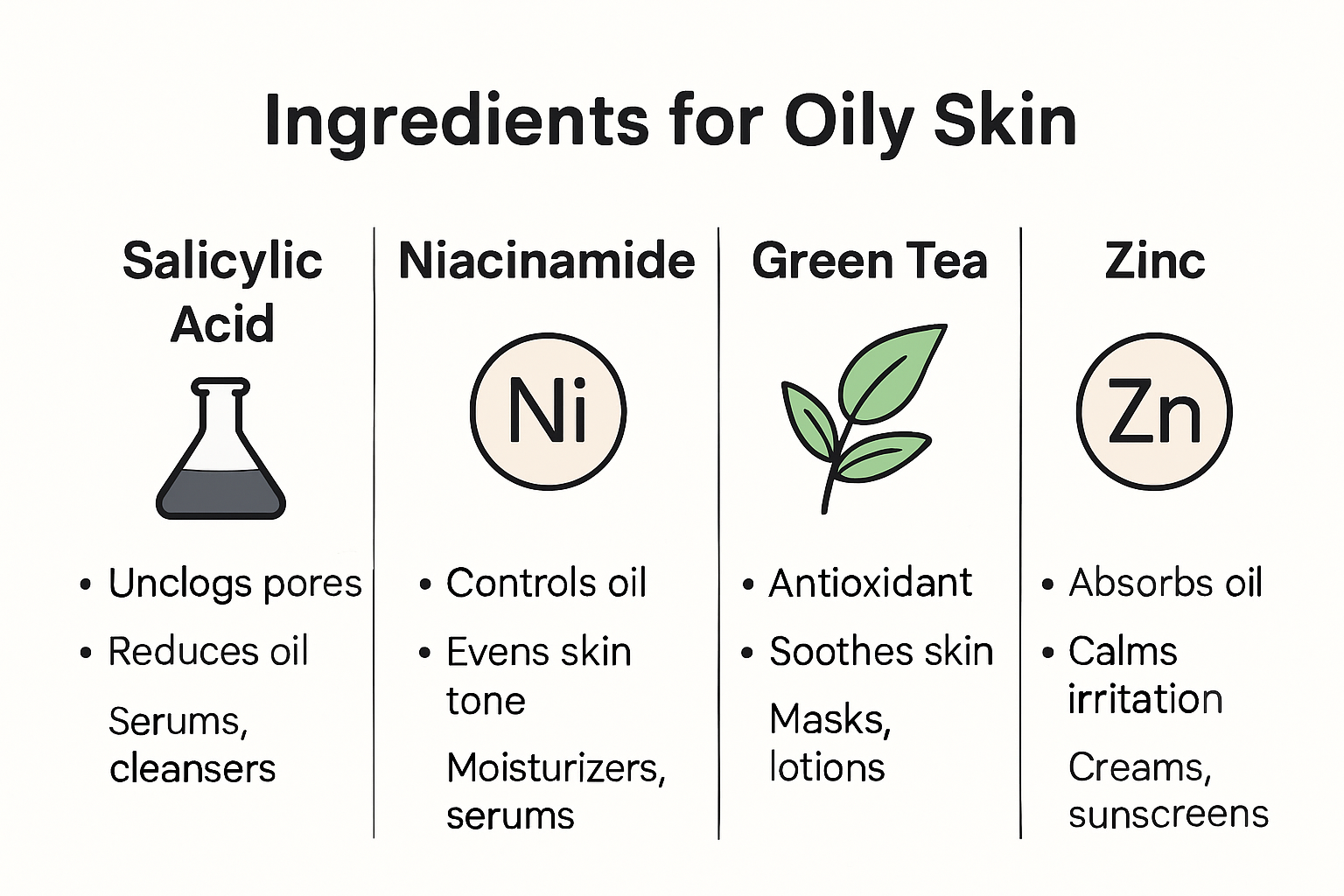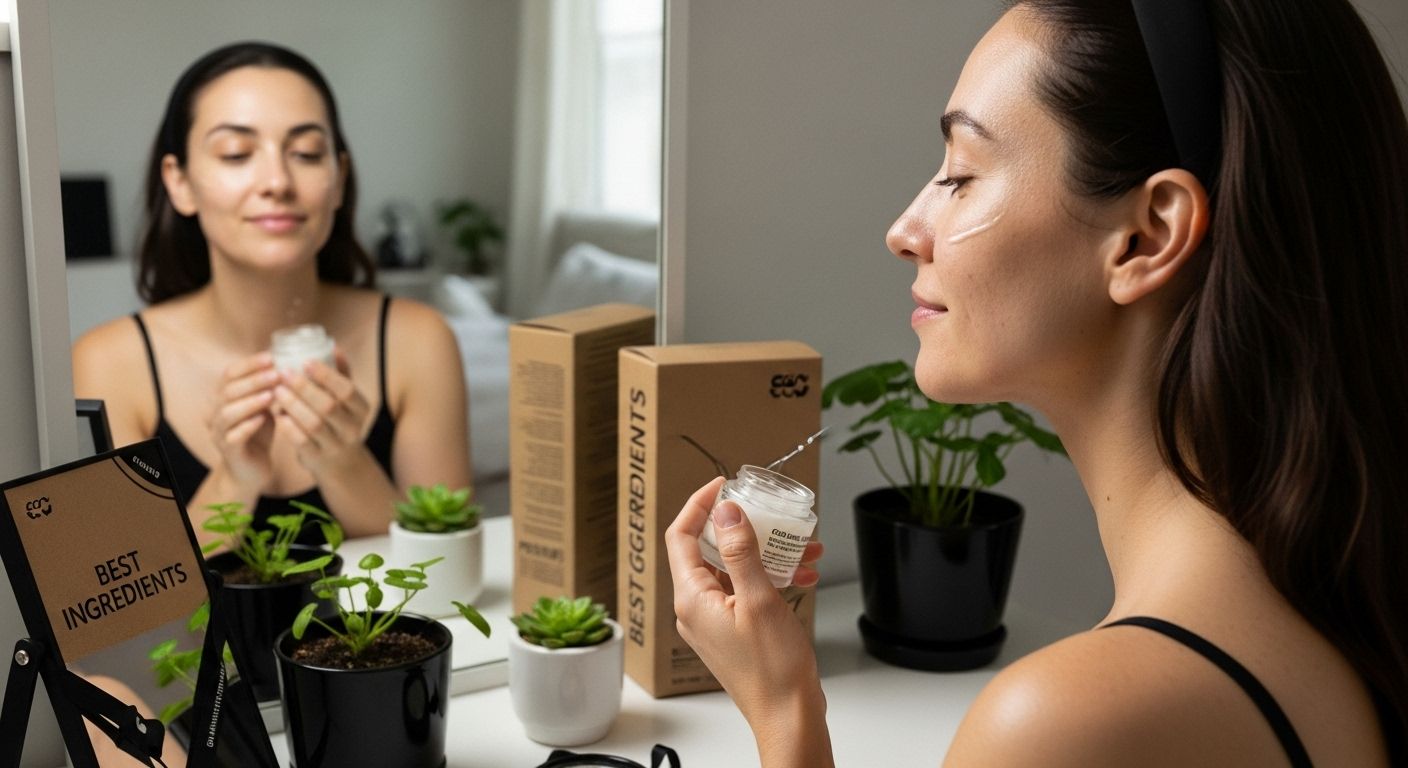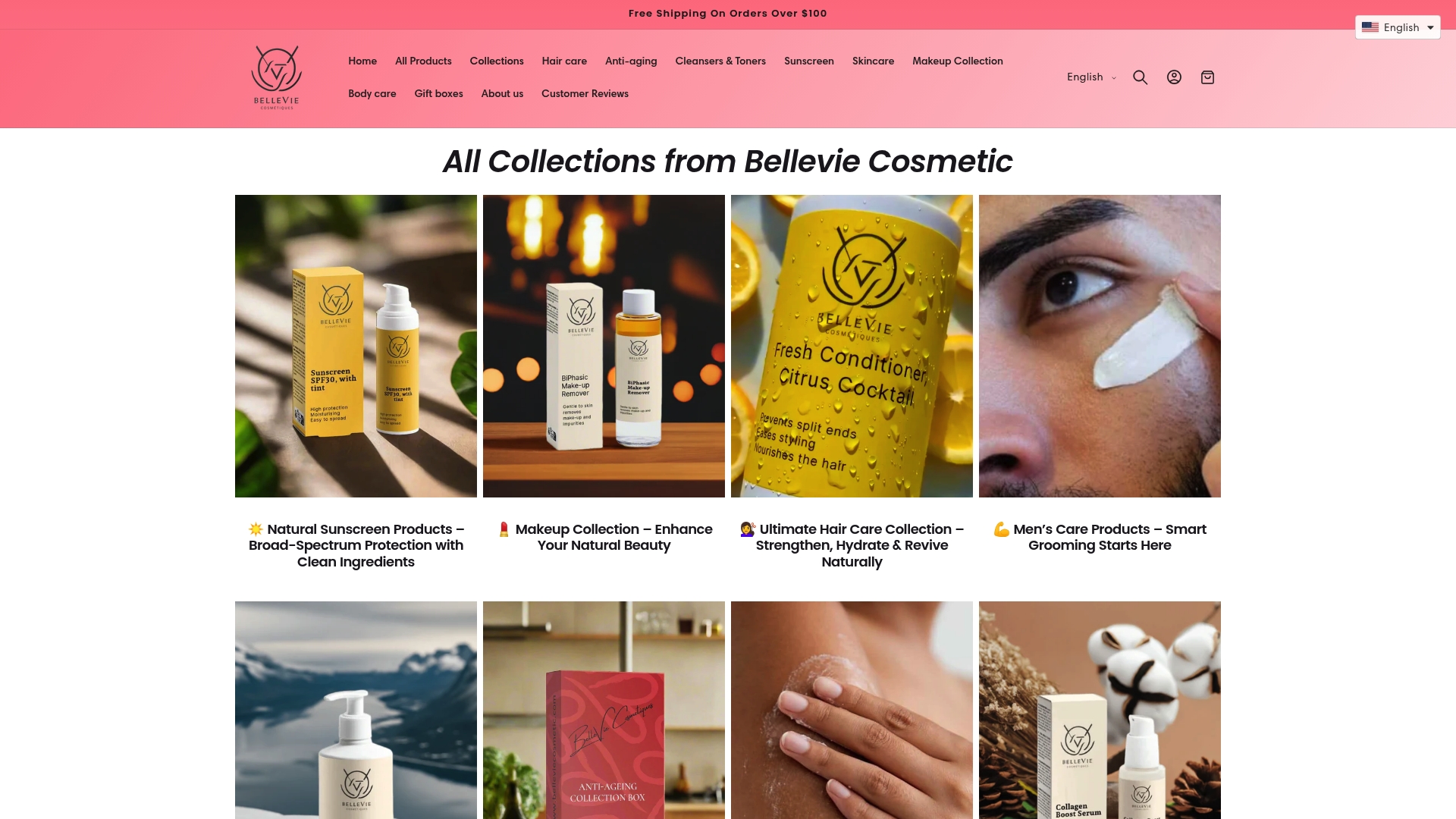
Oily skin can make your face shine for all the wrong reasons and leave you searching for new solutions every month. Even with a shelf full of cleansers and creams, nothing seems to stop the constant oil slick. Yet most people never realize that oily skin affects up to 35 percent of adults—not just teenagers. That changes everything you thought you knew and opens the door to simple fixes hiding in plain sight.
Table of Contents
- Understanding Oily Skin And Its Causes
- Daily Routine For Treating Oily Skin
- Best Ingredients And Products For Oily Skin
- Clean Beauty Tips And Eco-Friendly Routines
Quick Summary
| Takeaway | Explanation |
|---|---|
| Identify your skin type accurately | Understanding that oily skin can stem from hormones, genetics, and environment helps you tailor your skincare approach. |
| Adopt a consistent cleansing routine | Gentle cleansing twice daily with suitable products prevents excessive oil without stripping skin moisture. |
| Use targeted ingredients effectively | Incorporate ingredients like salicylic acid and niacinamide to control oil and improve skin texture. |
| Moisturize with lightweight products | Even oily skin requires hydration; opt for oil-free moisturizers that balance moisture without clogging pores. |
| Prioritize clean and sustainable products | Choose products with natural ingredients and eco-friendly packaging to support both skin health and environmental responsibility. |
Understanding Oily Skin and Its Causes
Oily skin is a complex dermatological condition characterized by excessive sebum production, which can lead to a shiny appearance, enlarged pores, and potential acne breakouts. Understanding the underlying mechanisms and root causes of oily skin is crucial for developing an effective skincare strategy.
The Science Behind Sebum Production
Sebum, an oily substance produced by sebaceous glands, plays a critical role in protecting and maintaining skin health. However, when these glands become overactive, they generate more oil than necessary. Research published in the Clinical, Cosmetic and Investigational Dermatology journal reveals that multiple factors contribute to increased sebum production.
Hormonal fluctuations represent a primary driver of excessive oil production. Androgens, particularly during puberty, menstruation, and pregnancy, can stimulate sebaceous glands to increase oil secretion. Genetics also play a significant role, with some individuals genetically predisposed to having more active sebaceous glands.
Environmental and Lifestyle Influences
Beyond hormonal factors, external elements substantially impact skin oil levels. Humidity, heat, and excessive sweating can trigger increased sebum production as the body attempts to cool itself and maintain skin hydration. Climate and geographic location can dramatically influence skin behavior.
Diet and stress are additional critical contributors. Dermatological studies suggest that high glycemic index foods and dairy products might exacerbate sebum production. Chronic stress elevates cortisol levels, which can further stimulate oil glands and potentially lead to more pronounced skin issues.
Age and Skin Changes
Contrary to popular belief, oily skin is not exclusively a teenage concern. While adolescents experience the most dramatic hormonal shifts, adults can also struggle with excess oil production. Skin changes occur throughout different life stages, with hormonal fluctuations during perimenopause and menopause potentially triggering renewed sebum activity.
Interestingly, skin’s oil production tends to decrease with age. As collagen and elastin production decline, sebaceous glands become less active. However, this does not guarantee relief from oily skin concerns, as individual genetic and environmental factors continue to play significant roles.
Understanding these complex interactions provides a foundation for developing targeted skincare approaches. By recognizing that oily skin results from a combination of internal and external factors, individuals can make informed decisions about managing their unique skin profile.
Daily Routine for Treating Oily Skin
Managing oily skin requires a strategic and consistent daily approach that balances cleansing, hydration, and targeted treatment. By implementing a carefully curated skincare routine, individuals can effectively control excess sebum production and maintain a healthy, balanced complexion.
The following process table outlines an ideal daily skincare routine for treating oily skin, breaking down the morning and evening steps with their key actions and recommended product types.
| Routine Step | Time of Day | Key Action or Focus | Recommended Product Type |
|---|---|---|---|
| Cleanse | Morning | Remove overnight oil without stripping skin | Gentle pH-balanced cleanser |
| Treat/Serum | Morning | Control oil, hydrate, refine pores | Serum (niacinamide/hyaluronic acid) |
| Moisturize | Morning | Provide lightweight hydration | Oil-free gel or water-based moisturizer |
| Protect | Morning | Prevent UV-triggered oil production | Non-comedogenic sunscreen |
| Cleanse | Evening | Remove makeup, sebum, and impurities | Double cleanse (oil + water-based) |
| Exfoliate/Mask (2-3x/week) | Evening | Unclog pores, absorb excess oil | Salicylic/glycolic acid exfoliant, clay mask |
| Moisturize | Evening | Rebalance and repair skin | Lightweight, non-comedogenic moisturizer |
Morning Cleansing and Preparation
Research published in the Journal of Clinical and Aesthetic Dermatology emphasizes the importance of gentle, twice-daily cleansing for individuals with oily skin. The morning routine should begin with a mild, pH-balanced cleanser specifically formulated to remove overnight oil accumulation without stripping the skin’s natural protective barrier.
Choose a cleanser containing ingredients like salicylic acid or niacinamide, which help regulate sebum production and provide gentle exfoliation. Avoid harsh, alcohol-based products that can trigger increased oil production as a compensatory mechanism. Lukewarm water is recommended, as hot water can stimulate additional sebum secretion and potentially irritate the skin.
Targeted Treatment and Hydration
After cleansing, apply a lightweight, oil-free moisturizer to prevent dehydration. Counterintuitively, skipping moisturizer can lead to increased oil production as the skin attempts to compensate for perceived dryness. Dermatological research from the American Academy of Dermatology suggests using gel-based or water-based moisturizers that provide hydration without clogging pores.
Incorporate a lightweight serum containing ingredients like hyaluronic acid for hydration and niacinamide for oil control. These targeted treatments can help balance skin moisture levels and reduce the appearance of enlarged pores. For additional protection, apply a non-comedogenic sunscreen with at least SPF 30 to shield the skin from UV rays that can potentially stimulate additional oil production.
Evening Skincare and Maintenance
The evening routine should focus on thorough yet gentle cleansing and repair. Double cleansing can be particularly effective for oily skin types. Start with an oil-based cleanser to dissolve makeup and excess sebum, followed by a water-based cleanser to remove remaining impurities. This method ensures comprehensive cleansing without over-stripping the skin.
Consider incorporating chemical exfoliants like glycolic or salicylic acid 2-3 times per week to help unclog pores and regulate oil production. However, moderation is key. Over-exfoliation can damage the skin’s protective barrier and trigger increased oil production. Use these treatments sparingly and always follow with a lightweight, non-comedogenic moisturizer.
Additionally, consider using clay masks once weekly to help absorb excess oil and minimize the appearance of pores. Look for masks containing kaolin or bentonite clay, which are known for their oil-absorbing properties. Remember that consistency and gentleness are crucial in managing oily skin. Avoid harsh treatments that can disrupt the skin’s natural balance and potentially exacerbate oil production.
Best Ingredients and Products for Oily Skin
Navigating the world of skincare for oily skin requires understanding the most effective ingredients that can help balance sebum production, minimize pores, and maintain overall skin health. Selecting the right products with targeted ingredients can transform your skincare routine and address specific concerns associated with excess oil.
Scientifically Proven Active Ingredients
Research from the National Institutes of Health identifies several powerhouse ingredients specifically beneficial for managing oily skin. Topical retinoids, salicylic acid, niacinamide, and zinc emerge as standout components with proven sebostatic properties.
Salicylic acid, a beta-hydroxy acid (BHA), stands out for its exceptional ability to penetrate and unclog pores. This oil-soluble ingredient can dissolve excess sebum and dead skin cells, preventing potential breakouts and reducing the appearance of enlarged pores. Its exfoliating properties help regulate oil production while promoting a clearer, smoother complexion.
Niacinamide offers multiple benefits for oily skin types. This versatile ingredient helps regulate sebum production, minimizes pore appearance, and provides anti-inflammatory properties. Studies demonstrate its effectiveness in reducing oil secretion and improving overall skin texture without causing excessive dryness.

Natural and Botanical Oil-Control Solutions
Dermatological research from the Journal of Cosmetic Dermatology highlights several natural ingredients that effectively manage oily skin. Green tea extract, known for its powerful antioxidant properties, helps control sebum production and provides anti-inflammatory benefits. Witch hazel serves as a natural astringent, helping to tighten pores and reduce excess oil without stripping the skin.
Zinc represents another crucial ingredient for managing oily skin. This mineral helps regulate oil production, provides antibacterial properties, and supports skin healing. Clay-based products containing zinc can absorb excess sebum and help mattify the skin’s appearance. Look for lightweight, non-comedogenic formulations that incorporate these natural ingredients.
Here is a comparison table summarizing scientifically proven active ingredients and natural/botanical solutions for oily skin, including their primary benefits and example product types. This helps readers quickly identify the most relevant options for their skincare needs.
| Ingredient/Source | Key Benefit for Oily Skin | Example Product Type |
|---|---|---|
| Salicylic Acid | Unclogs pores, regulates sebum | Cleanser, exfoliant |
| Niacinamide | Reduces oil, minimizes pores, anti-inflammatory | Serum, moisturizer |
| Zinc | Regulates oil, antibacterial, healing | Clay mask, spot treatment |
| Retinoids | Sebum regulation, improves skin texture | Serum, night treatment |
| Green Tea Extract | Antioxidant, reduces sebum, anti-inflammatory | Toner, moisturizer |
| Witch Hazel | Tightens pores, reduces excess oil | Toner, facial mist |
| Kaolin/Bentonite Clay | Absorbs oil, minimizes pores | Clay mask |
Comprehensive Product Selection Strategies
When selecting products for oily skin, prioritize lightweight, gel-based formulations that provide hydration without added heaviness. Seek out non-comedogenic labels, which indicate products designed to avoid clogging pores. Ingredients like hyaluronic acid can provide essential hydration without increasing oil production, helping maintain the skin’s natural balance.
Consider building a skincare routine that includes a gentle cleanser with salicylic acid, a niacinamide-based serum, and a lightweight moisturizer. Rotate clay masks into your weekly routine to help control excess oil and provide deep cleansing. Always patch test new products and introduce them gradually to monitor your skin’s response.

Remember that managing oily skin is not about complete oil elimination but achieving a balanced, healthy complexion. Individual skin responses vary, so patience and consistent care are key to finding the most effective ingredients and products for your unique skin profile.
Clean Beauty Tips and Eco-Friendly Routines
Clean beauty represents more than a trend—it’s a holistic approach to skincare that prioritizes both personal health and environmental sustainability. For individuals managing oily skin, adopting clean and eco-friendly routines can provide effective solutions while minimizing ecological impact.
Botanical Ingredients and Sustainable Skincare
Research published in the International Journal of Molecular Sciences highlights the efficacy of botanical ingredients in managing oily skin. Green tea extract, witch hazel, and niacinamide emerge as powerful natural alternatives to synthetic chemicals, offering anti-inflammatory and sebum-regulating properties without compromising skin health.
Opting for plant-derived ingredients means selecting products with minimal, traceable components. Look for skincare lines that prioritize organic, sustainably sourced botanicals. These ingredients not only provide targeted skin benefits but also reduce the environmental footprint associated with traditional skincare manufacturing.
Minimalist Approach to Product Selection
Sustainable cosmetic research emphasizes the importance of a minimalistic skincare routine. By reducing the number of products and choosing multi-functional formulations, you can decrease waste and potential skin irritation. This approach is particularly beneficial for oily skin types, which are often more sensitive to complex product combinations.
Consider implementing a streamlined routine with versatile products. Seek out multi-purpose items like tinted moisturizers with SPF, cleansers that also provide gentle exfoliation, and serums that address multiple skin concerns simultaneously. These strategies not only simplify your skincare regimen but also reduce packaging waste and resource consumption.
Eco-Conscious Packaging and Consumption
Beyond ingredient selection, clean beauty extends to packaging and overall consumption patterns. Choose brands that utilize recycled materials, offer refillable containers, or provide minimal packaging. Glass and aluminum containers are often more recyclable than traditional plastic packaging, making them more environmentally friendly alternatives.
Consider supporting brands that demonstrate transparent sustainability practices. Look for certifications like cruelty-free, vegan, or organic labels. These indicators often signify a commitment to ethical production and environmental responsibility. Additionally, purchasing products from local or smaller-scale manufacturers can further reduce the carbon footprint associated with long-distance shipping.
Ultimately, clean beauty for oily skin is about making informed, conscious choices. By prioritizing natural ingredients, minimalist routines, and sustainable practices, you can achieve a balanced complexion while contributing to broader environmental conservation efforts. Remember that individual skin responses vary, so patience and careful product selection remain key to developing an effective, eco-friendly skincare strategy.
Frequently Asked Questions
What are the best ingredients for treating oily skin?
Ingredients like salicylic acid, niacinamide, and zinc are highly effective for managing oily skin. Salicylic acid helps unclog pores, niacinamide regulates oil production, and zinc provides antibacterial properties to support healing.
How can I establish a daily skincare routine for oily skin?
A daily routine should include gentle cleansing twice daily, using a lightweight, oil-free moisturizer, incorporating a targeted serum with beneficial ingredients, and applying non-comedogenic sunscreen during the day.
Is it necessary to moisturize oily skin?
Yes, moisturizing oily skin is essential. Using an oil-free or gel-based moisturizer helps maintain skin hydration without clogging pores, which can actually reduce oil production over time.
How often should I exfoliate oily skin?
For oily skin, exfoliating 2-3 times a week is recommended. Using products with salicylic or glycolic acid can help unclog pores and regulate oil levels without over-exfoliating the skin.
Transform Your Oily Skin Routine with Pure Results
Have you tried countless cleansers and moisturizers, only to feel shinier and more frustrated each day? If finding gentle, effective solutions for oily skin feels overwhelming, BelleVie Cosmetic offers exactly what your daily routine is missing. Our clean beauty collections feature dermatologist-approved ingredients like niacinamide, zinc, gentle clay masks, and natural botanical extracts. These formulas are crafted in Europe without harsh chemicals, so you can target sebum control, hydrate without heaviness, and restore a healthy skin balance while supporting your clean lifestyle.
It is time to switch to skincare designed for real results. Visit BelleVie Cosmetic now and explore our range of oil-balancing solutions. Shop today and enjoy fast US shipping plus a free skincare gift with qualifying orders. Take control of your skin and experience the difference clean beauty can make.
💬 Need help with oily skin?
Talk directly with our AI Skincare Advisor on Instagram and get tailored product tips & skincare routines for oily, acne-prone, or sensitive skin.
👉 Chat Now on Instagram AI
